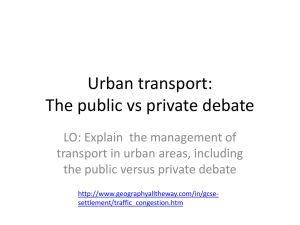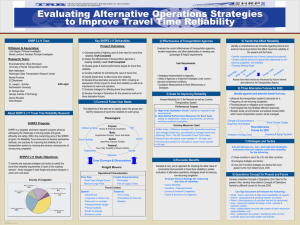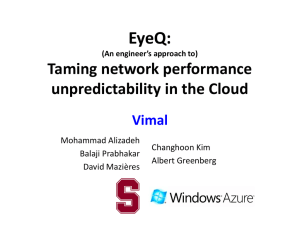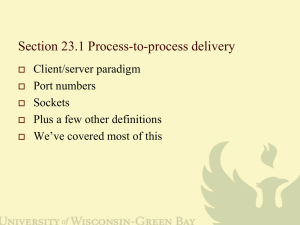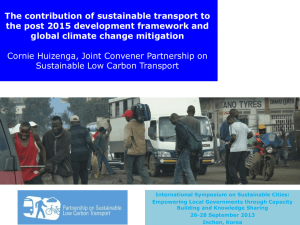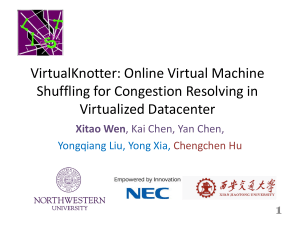Approximation Algorithms for Graph Routing Problems
advertisement
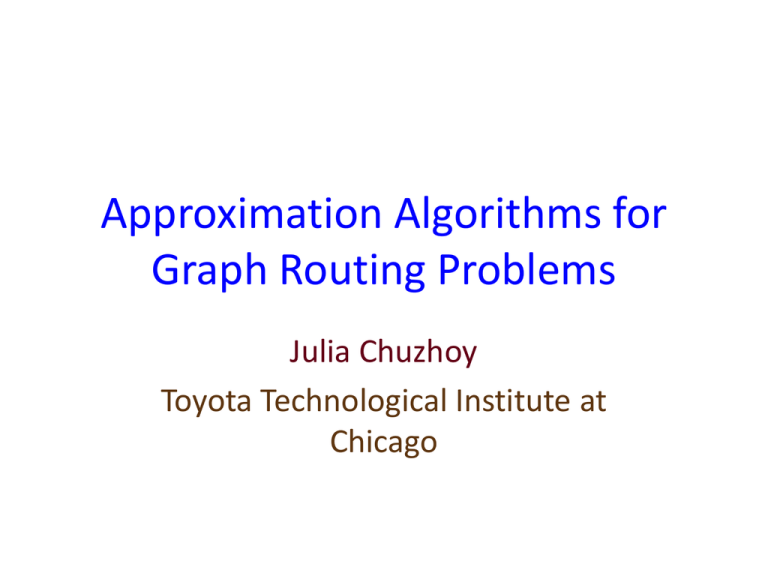
Approximation Algorithms for Graph Routing Problems Julia Chuzhoy Toyota Technological Institute at Chicago Routing Problems Input: Graph G, source-sink pairs (s1,t1),…,(sk,tk). Goal: Route as many pairs as possible; minimize edge congestion. Routing Problems Input: Graph G, source-sink pairs (s1,t1),…,(sk,tk). Goal: Route as many pairs as possible; minimize edge congestion. Routing Problems Input: Graph G, source-sink pairs (s1,t1),…,(sk,tk). Goal: Route as many pairs as possible; minimize edge congestion. Edge congestion: 2 Routing Problems Input: Graph G, source-sink pairs (s1,t1),…,(sk,tk). Goal: Route as many pairs as possible; minimize edge congestion. n – number of graph vertices m – number of edges k – number of demand pairs terminals – vertices participating in the demand pairs Routing Problems Input: Graph G, source-sink pairs (s1,t1),…,(sk,tk). Goal: Route as many pairs as possible; minimize edge congestion. • 3 pairs with congestion 2 Routing Problems Input: Graph G, source-sink pairs (s1,t1),…,(sk,tk). Goal: Route as many pairs as possible; minimize edge congestion. • 3 pairs with congestion 2 • 2 pairs with congestion 1 Congestion Minimization Congestion Minimization • Route all demand pairs • Minimize maximum edge congestion solution value: 2 LP-relaxation Rounding Algorithm [Raghavan, Thompson ‘87] • Every pair (si,ti) chooses a path P w. probability f(P) • Max edge congestion O(clog n/log log n) w.h.p. Congestion Minimization • -approximation [Raghavan, Thompson ‘87] • Directed graphs: -hard to approximate [Andrews, Zhang ‘06], [C, Guruswami, Khanna, Talwar ‘07] • Undirected graphs: -hard to approximate [Andrews, Zhang ‘07] Open Problem 1 Can we close the gap for undirected graphs? • What is the integrality gap of the LP? • What if we only need to connect a constant fraction of the demand pairs? Edge-Disjoint Paths Problem • No congestion allowed • Route maximum number of the demand pairs Solution value: 2 Edge Disjoint Paths (EDP) • For directed graphs NP-hard even with only two demand pairs [Fortune, Hopcroft, Wyllie '80] • When k is constant, can be solved efficiently in undirected graphs [Robertson, Seymour ‘90] • NP-hard when k is part of input [Karp ’72] LP-relaxation Rounding Algorithm [Kolliopoulos, Stein ‘98] • Find shortest path P with non-zero flow, connecting any demand pair. • Add P to the solution and delete all flow that uses edges of P. -approximation Analysis • If the length of P is less than flow is deleted. • If the length of P is more than flow remains. – at most – at most Can We Do Better? Directed graphs: EDP is -hard to approximate for any [Guruswami, Khanna, Rajaraman, Shepherd, Yannakakis ‘99] Undirected graphs: • -approximation algorithm [Chekuri, Khanna, Shepherd ’06]. • -hardness of approximation for any[Andrews, Zhang ‘05], [Andrews, C, Guruswami, Khanna, Talwar, Zhang ’10] • LP integrality gap: ‘93] [Garg, Vazirani, Yannakakis Integrality Gap Example [Garg, Vazirani, Yannakakis ‘93] t1 t2 … tk s1 s2 … sk • fractional: k/2 • integral: 1 • k= A Brick-Wall Graph s1 tk … s2 … t2 sk t1 Open Problem 2 Close the gap for undirected EDP • planar graphs? – constant-factor approximation with congestion 2 [Chekuri, Khanna, Shepherd ‘04], [Chekuri, Khanna, Shepherd ‘06], [Seguin-Charbonneau, Shepherd ‘11] – O(log n)-approximation for Eulerian or 4-edge connected planar graphs [Kawarabayashi, Kobayashi ’10] – constant approximation for grid-like graphs [Kleinberg, Tardos ’95] Open Problem 2 Close the gap for undirected EDP • planar graphs? • better algorithms for brick-wall graphs? Positive Results Moderately connected graphs: If global min-cut is Ω(log5n), there is a polylog-approximation [Rao, Zhou ‘10] Expander graphs In a strong enough constant-degree expander, any demand set on vertices can be routed on edge-disjoint paths [Frieze ‘00] … Edge Disjoint Paths (EDP) Congestion Minimization Route maximum number of pairs on edge-disjoint paths Route all pairs; minimize congestion • -approximation • matching integrality gap • • • -hardness -approximation -hardness EDP with Congestion (EDPwC) A factor- approximation algorithm with congestion c routes . demand pairs with congestion at most c. optimum number of pairs with no congestion allowed EDPwC • Congestion O(log n/log log n): constant approximation [Raghavan, Thompson ’87] • -approximation with congestion c [Azar, Regev ’01], [Baveja, Srinivasan ’00], [Kolliopoulos, Stein ‘04] Directed graphs: -hardness for any congestion c [C, Guruswami, Khanna, Talwar ’06] EDPwC • Congestion O(log n/log log n): constant approximation [Raghavan, Thompson ’87] • -approximation with congestion c [Azar, Regev ’01], [Baveja, Srinivasan ’00], [Kolliopoulos, Stein ‘04] • polylog(n)-approximation with congestion poly(log log n) [Andrews ‘10] • Congestion 2: -approximation [Kawarabayashi, Kobayashi ’11] • polylog(k)-approximation with congestion 14 [C, ‘11] • polylog(k)-approximation with congestion 2 [C, Li, ‘12] Integrality Gaps for EDPwC • Congestion 1: integrality gap [Garg, Vazirani, Yannakakis ‘93] • Congestion c: integrality gap [Andrews, C, Guruswami, Khanna, Talwar, Zhang ‘10] • -hard to approximate with t1 congestion c for any t2 … tk s 1 s2 … s k Edge Disjoint Paths (EDP) Congestion Minimization Route maximum number of pairs on edge-disjoint paths Route all pairs; minimize congestion • -approximation • matching integrality gap • • • -hardness -approximation -hardness EDP with Congestion (EDPwC) • polylog(k)-approximation with congestion 2 • -hardness with congestion c Another View: Reducing Congestion • Suppose we have a “bad” solution, where X pairs are routed with congestion C. • Then we can route X/(C polylog k) pairs with congestion 2! • But if we want congestion 1, may only be able to route pairs, even if C=2. A Polylogarithmic Approximation with Constant Congestion Well-Linkedness [Robertson,Seymour], [Chekuri, Khanna, Shepherd], [Raecke] Graph G is well-linked for the set T of terminals, iff for any partition (A,B) of V(G), Well-Linkedness [Robertson,Seymour], [Chekuri, Khanna, Shepherd], [Raecke] Graph G is well-linked for the set T of terminals, iff for any partition (A,B) of V(G), Pre-Processing Input: Graph G, source-sink pairs (s1,t1),…,(sk,tk). Theorem [Chekuri, Khanna Shepherd ‘04] Can efficiently partition G into disjoint subgraphs G1,…,toGsolve that: “Enough” the problem on wellr, such linked instances. Gi the • For each induced sub-problem terminals are well-linked • Total fractional solution value for all induced sub-problems is High-Level Plan [CKS ‘04] 1. Embed an expander on a subset of terminals into G. Crossbar – expander vertices – expander edges terminals paths in G 2. Route a subset of the demand pairs in the Embedding congestion: max load on any edge of G expander Goal Embed an expander over a subset of terminals into G. • Include polylog(k)-fraction of the terminals • congestion 2 Cut-Matching Game [Khandekar, Rao, Vazirani ’06] Cut Player: wants to build an expander Matching Player: wants to delay its construction There is a strategy for cut player, s.t. after O(log2n) iterations, we get an expander! Embedding Expander into Graph Embedding Expander into Graph After O(log2k) iterations, we get an expander embedded into G. Problem: congestion Ω(log2k) Solution? Idea [Rao Zhou ‘06]: • Split G into graphs G1,…,Gh using algorithm of [Karger ’93] – – – – V(Gi)=V(G) for all i Every edge of G belongs to at most one Gi Each Gi well-linked for the terminals h=O(log2k) • Run the cut-matching game. Use Gi to route flow in iteration i. Problem: Can only do it if min-cut in G is Ω(log5n) • [Andrews ‘10] adapted this to general graphs, with congestion poly(log log n) Getting a Constant Congestion Embedding an Expander into G Expander vertex connected component in G containing the terminal Expander edge path connecting some pair of vertices in the two components An edge of G belongs to at most 2 of the components/paths. Embedding an Expander into G Routing on vertex-disjoint paths in X gives a congestion-2 routing in G! Embedding an Expander into G Expander vertex connected component in G containing the terminal Expander edge path connecting some pair of vertices in the two components An edge of G belongs to at most 2 of the components/paths. Embedding an Expander into G Families of Good Vertex Sets Good Vertex Subset S is a good vertex subset iff: • S contains no terminals • k/polylog k red edges • S is well-linked for the red edges A Good Family of Vertex Subsets • O(log2k) disjoint good vertex subsets • k/polylog k trees − each edge of G participates in at most 2 trees − Each tree Ti spans a distinct terminal ti and a distinct red edge adjacent to Sj for each j. Embedding an Expander Embedding an Expander Expander vertex the tree spanning the terminal Expander edges: via the cut-matching game of [KRV] Embedding an Expander Embedding an Expander After O(log2k) iterations, we obtain an expander embedded into G with congestion 2.… Algorithm for EDPwC Find a good family of vertex subsets Embed an expander into G Find vertex-disjoint routing in the expander Transform into routing in G Open Problem 3 • A cleaner algorithm for polylog(k) approximation with congestion 2? Better power of polylog? • What if we need to route almost all demand pairs (a constant fraction)? Routing on Vertex-Disjoint Paths • Generalizes EDP • Connections to Graph Minor theory No congestion: • -approximation [Kolliopoulos, Stein ‘98] • -lower bound on LP integrality gap [Garg, Vazirani, Yannakakis ‘97] Routing with congestion: • O(poly log k)-approximation with constant congestion [Chekuri, Ene ‘12] Open Problem 4 • Better algorithms/lower bounds for VertexDisjoint Paths? Open Problem 4 • Better algorithms/lower bounds for VertexDisjoint Paths? • Vertex-disjoint paths in grid graphs Open Problem 4 • Better algorithms/lower bounds for VertexDisjoint Paths? • Vertex-disjoint paths in grid graphs s1 s3 s2 t1 t2 t3 Thank you!
